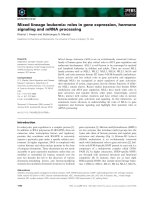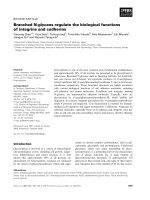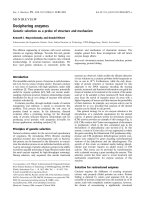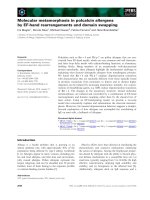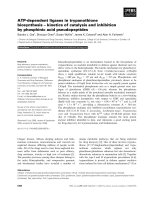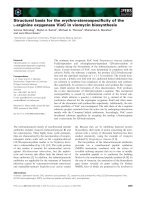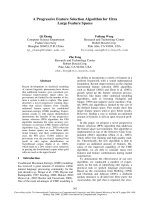Báo cáo khoa hoc:"Non-random mating for selection with restricted rates of inbreeding and overlapping generations" docx
Bạn đang xem bản rút gọn của tài liệu. Xem và tải ngay bản đầy đủ của tài liệu tại đây (274.17 KB, 17 trang )
Genet. Sel. Evol. 34 (2002) 23–39 23
© INRA, EDP Sciences, 2002
DOI: 10.1051/gse:2001002
Original article
Non-random mating for selection
with restricted rates of inbreeding
and overlapping generations
Anna K. S
ONESSON
∗
, Theo H.E. M
EUWISSEN
Institute for Animal Science and Health (ID-Lelystad), P.O. Box 65,
8200 AB Lelystad, The Netherlands
(Received 24 November 2000; accepted 8 August 2001)
Abstract – Minimum coancestry mating with a maximum of one offspring per mating pair
(MC1) is compared with random mating schemes for populations with overlapping generations.
Optimum contribution selection is used, whereby ∆F is restricted. For schemes with ∆F
restricted to 0.25% per year, 256 animals born per year and heritability of 0.25, genetic gain
increased with 18% compared with random mating. The effect of MC1 on genetic gain decreased
for larger schemes and schemes with a less stringent restriction on inbreeding. Breeding
schemes hardly changed when omitting the iteration on the generation interval to find an
optimum distribution of parents over age-classes, which saves computer time, but inbreeding
and genetic merit fluctuated more before the schemes had reached a steady-state. When bulls
were progeny tested, these progeny tested bulls were selected instead of the young bulls, which
led to increased generation intervals, increased selection intensity of bulls and increased genetic
gain (35% compared to a scheme without progeny testing for random mating). The effect of
MC1 decreased for schemes with progeny testing. MC1 mating increased genetic gain from
11–18% for overlapping and 1–4% for discrete generations, when comparing schemes with
similar genetic gain and size.
mating / overlapping generations /selection / rateof inbreeding /genetic response / optimum
contribution
1. INTRODUCTION
For breeding schemes, the selection step determines the increase in average
coancestry of the population, but the mating step can improve the genetic
structure of the population for the next round of selection. Caballero et al. [3]
concluded that non-random mating decreased the rate of inbreeding (∆F),
but had little effect on genetic response for BLUP and phenotypic selection.
A reduction of ∆F is, however, not expected when selection is made with
∗
Correspondence and reprints
E-mail:
24 A.K. Sonesson, T.H.E. Meuwissen
a restriction on ∆F, but instead the improved family structure due to non-
random mating can be used to increase the selection differential, i.e. to increase
genetic response [15]. When using optimum contribution with a restriction
on ∆F and discrete generations, minimum coancestry mating with only one
progeny per mating pair (MC1) increased genetic response from 5 through 23%
compared with random mating. The increase in genetic response was higher
when schemes were small or when the restriction on rate of inbreeding was
more stringent and can be explained by the effects of MC1 on the relationship
structure of the population. Minimum coancestry mating connects unrelated
families and avoids extreme relationships. Factorial mating schemes [17]
avoid extreme relationships by exchanging full-sib relationships for (maternal)
half-sib relationships, which is also done in the MC1 scheme by restricting
the number of progeny per mating pair to zero or one. Both these effects
result in a population with more homogenous relationships among animals.
Because MC1 mating makes relationships more homogenous across families,
the relationship among animals with the highest EBVs will be reduced. Hence,
it will be easier for optimum contribution selection to select animals with
the highest EBVs when MC1 mating is used instead of random mating. A
third effect of non-random mating, especially minimum coancestry mating, are
decreased inbreeding levels of the progeny and thus also of parents of the next
generation, which leads to a larger Mendelian sampling variance. A larger
Mendelian sampling variance leads to increased genetic variance and genetic
gain.
The above schemes were tested for populations that had discrete generations.
Most practical schemes however have overlapping generation structure. For
schemes with overlapping generations, parents are selected from several age-
classes, which makes their pedigrees more heterogeneous, so that the above
mentioned effects of MC1 mating on the relationship structure of the population
are advantageous. On the contrary, benefits of MC1 decrease with increasing
population size [15] and schemes with overlapping generations can be larger
than schemes with discrete generations. Hence, it is not clear how large the
benefits of MC1 mating will be for schemes with overlapping generations.
The aim of this study was to compare genetic gain, generation interval and
number of sires and dams selected for random and minimum coancestry mating
with only one progeny per mating pair. Optimum contribution selection will
be used for schemes with overlapping generations and with or without progeny
testing of sires. For schemes with overlapping generations, the algorithm
described in [12] iterates to obtain the optimum distribution of parents over
age-classes. The iteration process is rather computer intensive, and we also
studied the effect of omitting this iteration process and using the distribution
of parents over age-classes of the previous year. Note that this does not result
in a constant distribution of parents over age-classes, because the distribution
Mating schemes for optimum contribution selection 25
defined by the contribution of each animal may deviate from the distribution
of the last year. Finally, we compared schemes with overlapping and discrete
generations to see where minimum coancestry mating performs the best.
2. MATERIALS AND METHODS
2.1. Optimum contribution selection
The optimum contribution selection method for discrete generations was
presented by Meuwissen [11] and for overlapping generations by Meuwissen
and Sonesson [12]. In principle, the genetic response is maximised with two
restrictions. Firstly, there is a restriction on the contribution per sex, i.e. each
sex has to contribute 50% of the genes to the next generation. Secondly, a
constraint on the increase of the average relationship of selected parents limits
the inbreeding of each selection round. For populations with overlapping
generations, there are animals of different age-classes at year t from which
parents are selected and the different age-classes get different weights, r, which
equal their long-term contributions and which are derived from the gene-flow
theory of Hill [10]. The weights indicate how much age-classes are expected to
contribute in the future. The algorithm iterates on these weights such that the
contribution of each individual selection candidate, c
t
, and the contributions of
each age-class, r, are optimised. For discrete generations, only the contribution
of each individual selection candidate is optimised.
This iteration process over age-classes is rather computer intensive because
it results in many calculations of optimum c
t
. Therefore, we investigated
the consequences of omitting the iteration and simply using the distribution of
parents of the last year, c
t−1
, over age-classes to calculate r. This does not result
in a constant distribution of parents over age-classes, because the distribution
defined by c
t
may deviate from the distribution of the last year, which was used
to calculate r. For year one, r is 1/q, for all age-classes, where q is the number
of age-classes.
2.2. Mating
Two mating schemes described in Sonesson and Meuwissen [15] are used.
For random mating (RAND), sires and dams are allocated at random with
a probability that is proportional to the genetic contribution that they received
from the selection algorithm. Note that for the random mating scheme, the
actual number of offspring deviated from the optimal contributions due to
sampling of parents, which introduced some suboptimality in the schemes.
The non-random mating strategy minimises the average coancestry of sires
and dams, whereby the number of progeny per mating pair is restricted to zero
and one (MC1). MC1 gave the highest genetic gain of all schemes in the
26 A.K. Sonesson, T.H.E. Meuwissen
study for discrete generations [15]. For the MC1 scheme, a matrix F of size
(N
s
× N
d
) is set up, where N
s
(N
d
) is the number of selected sires (dams) and
F
ij
is the coefficient of coancestry of selected animals i and j, which is also the
inbreeding coefficient of their progeny. The simulated annealing algorithm [14]
was applied to find the mating pairs with average minimum coancestry. This
algorithm implies sampling of different mating pairs from the F matrix and
thereafter evaluating the average coancestry of every new solution. For each
sample, the total number of progeny per candidate has to equal the number
given from the selection algorithm, the c
t
vector, which reduces the number of
possible solutions (see Fig. 2 of [15]). If the average coancestry is lower than
for the previous solution, the new solution is accepted. If the average coancestry
is higher, the new solution is accepted with a probability that depends on the
number of samples and accepted changes made. The solution vector c
t
times
2N, rounded to integers, equals a vector of optimal number of progeny that
each candidate should obtain, where N is the total number of newborn progeny
per year. Normally, the truncation point for rounding up versus down is 0.5, but
if the total number of progeny did not sum to N, the truncation point is adjusted
such that N progeny result. This is not guaranteed to give the optimum integer
solution, but it probably yields a reasonable approximation for these relatively
large schemes. See Appendix of [15] for a more detailed explanation of the
MC1 algorithm.
2.3. Selection schemes
The parameters of the simulated breeding schemes are given in Table I.
The general structure was that of a closed nucleus breeding scheme for dairy
cattle, i.e. selection is for a sex-limited trait, which is recorded during the
reproductive age. The test daughters of progeny tested bulls came from
unrelated dams outside the nucleus. Genotypes, g
i
, for base animals were
sampled from a distribution N(0, σ
2
a
), where σ
2
a
is the base generation genetic
variance (Tab. I). Later years were obtained by simulating progeny genotypes
from g
i
=
1
2
g
s
+
1
2
g
d
+ m
i
, where s and d denote sire and dam of progeny i
and m
i
equals the Mendelian sampling component, which is sampled from
N
0,
1
2
(1 −
¯
F)σ
2
a
, where
¯
F is the average inbreeding coefficient of parents s
and d. For overlapping generations, phenotypes are simulated by adding terms
for permanent, pe
i
, and temporary environment, te
i
, which are sampled from the
distribution N(0, σ
2
pe
) and N(0, σ
2
te
), respectively, where σ
2
pe
is the permanent
environment variance and σ
2
te
is the temporary environment variance. For
discrete generations, only the term for the temporary environment is added.
Estimates of breeding values (EBVs) are obtained by using the BLUP breeding
value estimation procedure [9]. For overlapping generations, animals are
selected only on their EBVs during the first five years, and thereafter the
Mating schemes for optimum contribution selection 27
Table I. Parameters of the closed nucleus breeding scheme.
Size of selection scheme
Number of newborn progeny per year
(males plus females) 256, 512
Total number of years evaluated 20 or 30
Number of years before optimum selection started 5
Number of replicated simulations 100
Reproductive rate of males and females unlimited
Number of reproductive age-classes considered 10
Inbreeding constraint 0.25 or 0.50% per year
Genetic and permanent and temporary environmental variances of trait
Overlapping generations 0.10, 0.25 and 0.65 or
0.25, 0.25 and 0.50 or
0.50, 0.25 and 0.25
Discrete generations 0.25, 0.00 and 0.75
Parameters for schemes with overlapping generations
Age at which females completed lactation records 3, 4 and 5 years
(a)
Number of test daughters of bulls
for overlapping generations 0 or 100
Age at which progeny test became available 5 years
(a)
Involuntary culling rate of males and females 0.3
Voluntary culling rate negligible
(a)
When females are selected for this information, progeny are born one year later
(i.e. generation interval is one year longer than the age at which the information
becomes available).
optimum contribution algorithm is used for another 15 years for schemes
without the progeny test and another 25 years for schemes with the progeny
test.
For the comparison between discrete and overlapping schemes, we com-
pared genetic gain for three discrete schemes with the same (restricted) ∆F
and genetic gain (∆G) per generation as the overlapping scheme. For the
discrete schemes, the number of candidates per generation, i.e. a comparable
size and selection differential, was found by trial and error such that ∆G per
generation equalled that of the overlapping schemes. Average results from
generations 5 through 9 were used, because the discrete scheme converged
to equilibrium values after about five generations. Rates of inbreeding of the
discrete and overlapping schemes were equalised by the inbreeding constraints
per generation. The results were based on 100 replicated schemes.
28 A.K. Sonesson, T.H.E. Meuwissen
0
0. 01
0. 02
0. 03
0. 04
0 5 1 0 1 5 2 0
Year
F
R A N D R A N D _ N I T M C 1 M C 1 _ N I T
Figure 1. Inbreeding (F) for schemes with ∆F restricted to 0.25%, heritability of 0.25
and 256 new-born animals per year. RAND = random mating, MC1 = minimum
coancestry mating with one progeny per mating pair, RAND_NIT and MC1_NIT do
not iterate on generation intervals.
3. RESULTS
3.1. Rate of inbreeding
The rate of inbreeding (∆F) did not significantly exceed the restricted level,
0.25 or 0.50% per year (Tabs. II, III, IV and V). The level of inbreeding, F,
fluctuated more for RAND schemes than for MC1 schemes (Fig. 1). Similarly,
the level of inbreeding fluctuated more for schemes without iteration on the
generation interval than for schemes with iteration on the generation interval.
Note that there were first five years of BLUP selection, before the scheme with
a restriction on ∆F started. After the initial five years, all schemes needed
about four years (one generation) before the constraint became linear. These
problems in the beginning were due to different relationships of progeny of
different age-classes in the first years (see also [12]).
3.2. Genetic gain
3.2.1. Small scheme with low inbreeding
Genetic gain was higher for MC1 than for RAND schemes. For schemes
with a ∆F constrained to 0.25% per year, 256 newborn animals per year,
heritability of 0.25 and with iteration on the generation interval, genetic gain
per year, ∆G, was 0.071σ
p
units for MC1 and 0.060σ
p
units for RAND mating
schemes, i.e. ∆G was 18% higher for the MC1 schemes (Tab. II). The genetic
level fluctuated during the first years after the BLUP selection, following the
Mating schemes for optimum contribution selection 29
Table II. Rate of inbreeding per year (∆F), genetic gain per year (∆G), generation
interval (L) and the number of selected sires and dams (Sel.) for schemes with ∆F
restricted to 0.25% per year, 256 newborn animals per year, heritability level (h
2
)
of 0.10, 0.25 or 0.50, random or minimum coancestry mating and with or without
iteration on generation interval.
Method
(a)
∆F(se)
(b,c)
∆G(se)
(b,c)
L (sire/dam)
(c)
Sel. sire/dam
(c)
(%) (σ
p
-units) (years)
h
2
= 0.10
RAND 0.24 (0.07) 0.029 (0.005) 3.3/4.8 33.8/12.5
RAND_NIT 0.23 (0.06) 0.028 (0.005) 3.2/4.8 36.1/13.1
MC1 0.25 (0.05) 0.033 (0.005) 3.3/4.7 32.4/12.0
MC1_NIT 0.26 (0.03) 0.034 (0.004) 3.1/4.6 34.5/12.7
h
2
= 0.25
RAND 0.24 (0.05) 0.060 (0.007) 3.0/4.7 35.0/12.0
RAND_NIT 0.23 (0.05) 0.062 (0.007) 3.1/4.6 36.2/12.3
MC1 0.24 (0.04) 0.071 (0.007) 2.9/4.5 35.2/12.0
MC1_NIT 0.26 (0.03) 0.071 (0.007) 2.9/4.5 35.3/11.8
h
2
= 0.50
RAND 0.23 (0.05) 0.111 (0.010) 2.9/4.4 36.2/11.4
RAND_NIT 0.23 (0.05) 0.111 (0.010) 2.9/4.4 38.5/12.1
MC1 0.27 (0.04) 0.131 (0.009) 2.6/4.3 38.6/11.6
MC1_NIT 0.27 (0.03) 0.128 (0.009) 2.6/4.3 37.7/11.6
(a)
RAND = random mating, MC1 = minimum coancestry mating with only one
progeny per mating pair, RAND_NIT and MC1_NIT schemes do not iterate on
generation interval.
(b)
se = standard error.
(c)
Average year 16–20.
fluctuations of the level of inbreeding (Fig. 2), i.e. genetic gain increased when
the level of inbreeding increased and vice versa.
For the heritability levels of 0.10 and 0.50, ∆G was 14 and 18% higher for
MC1 schemes than for RAND schemes, respectively. Hence, the effect on ∆G
of MC1 mating is similar for different levels of heritability.
∆G did not differ significantly for schemes with or without iteration on the
generation interval.
3.2.2. Larger scheme
For the larger scheme (512 newborn animals per year) with ∆F restricted
to 0.25%, ∆G was 0.084σ
p
units for the MC1 schemes and 0.076σ
p
units for
30 A.K. Sonesson, T.H.E. Meuwissen
0
0. 2
0. 4
0. 6
0. 8
1
1 . 2
1 . 4
1 . 6
0 5 1 0 1 5 2 0
Year
G (
p
- u n i t )
RAND RAND_ NI T M C 1 M C 1 _ NI T
Figure 2. Genetic level (G) for schemes with ∆F restricted to 0.25%, heritability of
0.25 and 256 new-born animals per year. RAND = random mating, MC1 = minimum
coancestry mating with one progeny per mating pair, RAND_NIT and MC1_NIT do
not iterate on generation intervals.
Table III. Rate of inbreeding per year (∆F), genetic gain per year (∆G), generation
interval (L) and the number of selected sires and dams (Sel.) for schemes with ∆F
restricted to 0.25 or 0.50% per year, 256 or 512 newborn animals per year, heritability
level of 0.25, random or minimum coancestry mating and with or without iteration on
generation interval.
Method
(a)
∆F(se)
(b,c)
∆G(se)
(b,c)
L (sire/dam)
(c)
Sel. sire/dam
(c)
(%) (σ
p
-units) (years)
∆F = 0.25% and 512 newborn animals per year
RAND 0.24 (0.05) 0.076 (0.007) 2.8/4.6 40.1/13.2
RAND_NIT 0.26 (0.05) 0.073 (0.007) 2.8/4.5 39.8/13.5
MC1 0.27 (0.05) 0.084 (0.006) 2.8/4.4 42.1/13.9
MC1_NIT 0.27 (0.04) 0.086 (0.006) 2.8/4.4 40.9/13.8
∆F = 0.50% and 256 newborn animals per year
RAND 0.52 (0.21) 0.072 (0.010) 3.0/4.7 19.4/6.4
RAND_NIT 0.47 (0.12) 0.068 (0.009) 2.8/4.6 20.4/6.7
MC1 0.52 (0.16) 0.082 (0.010) 3.1/4.5 21.1/6.5
MC1_NIT 0.52 (0.11) 0.083 (0.009) 2.9/4.4 22.3/6.7
(a)
RAND = random mating, MC1 = minimum coancestry mating with only one
progeny per mating pair, RAND_NIT and MC1_NIT schemes do not iterate on
generation interval.
(b)
se = standard error.
(c)
Average year 16–20.
Mating schemes for optimum contribution selection 31
Table IV. Rate of inbreeding per year (∆F), genetic gain per year (∆G), generation
interval (L) and the number of selected sires and dams (Sel.) for schemes with ∆F
restricted to 0.25 or 0.50% per year, 256 newborn animals per year, heritability level of
0.25, random or minimum coancestry mating, with or without iteration on generation
interval and sires are yearly progeny tested on 100 daughters outside the nucleus.
Method
(a)
∆F(se)
(b,c)
∆G(se)
(b,c)
L (sire/dam)
(c)
Sel. sire/dam
(c)
(%) (σ
p
-units) (years)
∆F = 0.25%
RAND 0.24 (0.07) 0.081 (0.011) 5.9/4.3 9.6/12.6
RAND_NIT 0.26 (0.07) 0.081 (0.011) 5.9/4.3 9.7/11.6
MC1 0.27 (0.06) 0.087 (0.008) 6.1/4.1 7.4/13.9
MC1_NIT 0.25 (0.06) 0.088 (0.008) 6.1/4.1 6.4/13.0
∆F = 0.50%
RAND 0.48 (0.22) 0.096 (0.008) 6.1/4.4 4.6/6.8
RAND_NIT 0.41 (0.19) 0.085 (0.008) 6.1/4.3 4.1/6.0
MC1 0.51 (0.23) 0.099 (0.010) 6.2/4.1 4.0/7.8
MC1_NIT 0.47 (0.16) 0.095 (0.010) 6.2/4.1 4.0/8.0
(a)
RAND = random mating, MC1 = minimum coancestry mating with only one
progeny per mating pair, RAND_NIT and MC1_NIT schemes do not iterate on
generation interval.
(b)
se = standard error.
(c)
Average year 16–20.
the RAND schemes, i.e. ∆G was 11% higher for the MC1 schemes than for
the RAND schemes. Thus, the effect on ∆G of MC1 mating was somewhat
smaller for larger schemes.
3.2.3. Less stringent restriction on inbreeding
∆G for schemes with a less stringent restriction on ∆F (0.50%) was, as
expected, somewhat higher than for the scheme with a more stringent restriction
on ∆F in Table II (0.25%). For schemes with a heritability of 0.25, ∆G was
0.082σ
p
units for MC1 schemes and 0.072σ
p
units for RAND schemes, i.e.
∆G was 14% higher for the MC1 schemes than for RAND schemes (Tab. III).
Hence, the effect on ∆G of MC1 mating is somewhat smaller for schemes with
a less stringent restriction on inbreeding.
Again, ∆G did not differ significantly for schemes with or without iteration
on the generation interval.
32 A.K. Sonesson, T.H.E. Meuwissen
Table V. Rate of inbreeding per generation (∆F/gen), genetic gain per generation
(∆G/gen) and number of selected sires and dams (Sel.) for schemes with discrete
generations, ∆F restricted to 1 or 2% per generation, heritability level of 0.25 and
random or minimum coancestry mating.
Method
(a)
∆F/gen(se)
(b,c)
∆G/gen(se)
(b,c)
Sel. sire/dam
(c)
(%) (σ
p
-units)
∆F/gen = 1%, ∆G/gen = 0.24, number of animals = 324
RAND 1.01 (0.02) 0.240 (0.003) 74.7/31.8
MC1 0.96 (0.01) 0.247 (0.002) 70.9/28.9
∆F/gen = 2%, ∆G/gen = 0.29, number of animals = 400
RAND 1.99 (0.04) 0.294 (0.004) 43.2/18.1
MC1 2.02 (0.03) 0.307 (0.004) 41.9/17.8
∆F/gen = 1%, ∆G/gen = 0.30, number of animals = 752
RAND 0.99 (0.02) 0.308 (0.003) 86.1/37.5
MC1 0.98 (0.02) 0.312 (0.003) 79.7/35.8
(a)
RAND = random mating, MC1 = minimum coancestry mating with only one
progeny per mating pair.
(b)
se = standard error.
(c)
Average generation 5–9.
3.2.4. Scheme with progeny test
For schemes with progeny tests, ∆F constrained to 0.25% per year, 256
newborn animals per year, heritability of 0.25 and with iteration on the gen-
eration interval, ∆G was 0.087σ
p
units for MC1 and 0.081σ
p
units for RAND
mating schemes, i.e. ∆G was 7% higher for the MC1 schemes. Hence, the
effect on ∆G of MC1 mating was small for schemes with progeny tests.
Again, ∆G did not differ significantly for schemes with or without iteration
on the generation interval.
3.2.5. Comparison of schemes with overlapping and discrete
generations
Three schemes were compared for discrete and overlapping schemes: one
with a ∆F restricted to 0.25% per year and 256 newborn animals from Table II,
one with a ∆F restricted to 0.25% per year and 512 newborn animals from
Table III and one with a ∆F restricted to 0.50% per year and 256 newborn
animals from Table III. The generation interval was approximately 4 years on
average for all schemes and the comparison was made for the schemes with
Mating schemes for optimum contribution selection 33
h
2
= 0.25. The number of animals needed for the discrete schemes to achieve
the same genetic response per generation, i.e. same selection differential and
comparable number of selection candidates, as the overlapping scheme were
324, 400 and 752, for the three schemes, respectively. For the three discrete
schemes, ∆G was 3, 4 and 1% higher, respectively, for the MC1 scheme than
for the RAND scheme (Tab. V). For schemes with overlapping generations,
these figures were 18, 14 and 11%, respectively (Tabs. II and III). Hence,
the effect on ∆G of MC1 mating was larger for schemes with overlapping
generations than for schemes with discrete generations.
3.3. Number of selected animals and generation interval
3.3.1. Small scheme with low inbreeding
For schemes with ∆F constrained to 0.25% per year, 256 newborn animals
per year, heritability of 0.25 and an iteration on the generation interval, there
were on average 35.2 sires and 12.0 dams selected for MC1 schemes and 35.0
sires and 12.0 dams selected for the RAND schemes (Tab. II). Dams were
thus selected more intensively than sires, because of the higher accuracy of
selection of cows compared to sires [1,12]. There was, however, no difference
in the number of selected animals for the two mating schemes.
Generation intervals of the MC1 scheme for sires and dams were 2.9 and
4.5 years, respectively, which were very similar to the generation intervals of
the RAND scheme of 3.0 and 4.7 years for sires and dams, respectively.
For the different levels of h
2
, the same generation interval and number of
selected animals were achieved with RAND and MC1 schemes. Similarly,
iteration on generation intervals did not affect the breeding schemes.
3.3.2. Larger schemes and schemes with higher inbreeding
For the larger schemes (512 newborn animals per year) with the stringent
restriction on ∆F (0.25%), about the same number of animals were selected
(Tab. III), i.e. the selection intensity has increased for the larger schemes. For
the less stringent restriction on ∆F (0.50%), fewer animals were selected than
for the more stringent restriction (0.25%), i.e. selection intensity also increased
for this scheme with a less stringent restriction on ∆F.
3.3.3. Scheme with progeny tests
For the scheme where sires were progeny tested on 100 daughters outside
the nucleus, the progeny tested bulls were selected, which can be seen on the
generation interval of the selected sires (Tab. IV). The generation interval
for the sires was around 6 years for all schemes, which is the age when the
information of the progeny test becomes available. The generation interval for
34 A.K. Sonesson, T.H.E. Meuwissen
the dams was around 4 years as for the schemes without progeny tests (Tabs. II
and III).
For the scheme with a ∆F restricted to 0.25%, the selection intensity of
sires increased substantially, because the longer generation interval decreased
the ∆F per year, such that there were only about 8 sires selected (Tab. III),
compared with the scheme without progeny tests, where around 35 sires were
selected (Tab. II).
3.3.4. Comparison of schemes with overlapping and discrete
generations
For the scheme with discrete generations, there were somewhat fewer
females selected for the MC1 scheme in order to get the same selection intensity
as the RAND scheme. For example, for the scheme with ∆F restricted to 1%
per generation and 324 newborn animals per year, there were only 70.9 males
and 28.9 females selected for the MC1 schemes, whereas there were 74.7 males
and 31.8 females selected for the RAND schemes.
4. DISCUSSION
4.1. Comparison between RAND and MC1 matings
The MC1 mating scheme, which minimises the coancestry of mating pairs,
resulted in 18% higher ∆G than random mating schemes with a ∆F restricted to
0.25 per year, 256newborn animalsper year and h
2
= 0.25 (Tab. II). With larger
schemes (512 newborn animals per year) or a less stringent restriction on ∆F
(0.5% per year), the advantage of MC1 was somewhat reduced (Tab. III). With
minimum coancestry mating, relationships within a population become more
equal, because the least related animals are mated and with the restriction on
the number of progeny per mating pair to zero or one, as in the factorial mating
scheme of Woolliams [17], extreme relationships are avoided. The variance
of Mendelian sampling terms increases, due to lower levels of inbreeding of
the parents. These three effects give the selection algorithm an advantage at
the next round of selection, such that it can select mainly on the more variable
Mendelian sampling terms, i.e. there is less need to account for relationships
between animals since relationships are more equal.
The effect of MC1 on ∆G for schemes with progeny testing was much
smaller than for schemes without progeny testing, probably because the choices
between mating pairs are reduced, due to the smaller number of selected sires.
Progeny testing changed, however, the whole breeding scheme, resulting in
more intense selection of older sires and a substantially increased ∆G at the
same ∆F (35%, Tabs. II and IV). Here, each sire was tested on 100 daughters.
If the number of progeny tested daughters decreases, a new balance between
Mating schemes for optimum contribution selection 35
the use of proven versus young sires has to be found, which might result in the
selection of more young sires, and fewer proven sires.
The ∆G increased from 11 to 18% for MC1 compared with RAND mating
for the scheme with overlapping generations, whereas ∆G increased from 1
to 4% for the scheme with discrete generations at the same ∆F and ∆G per
generation (Tabs. II, III and V). The resulting scheme for discrete generations
was, however, rather large in size, such that the effect of non-random mating
was expected to be rather small [3,15]. Hence, MC1 mating seems more
effective for schemes with overlapping generations than for schemes with
discrete generations, when compared at the same rate of inbreeding per gener-
ation and similar size (number of candidates). Caballero et al. [3] found that
∆F was reduced about 50% more for schemes with overlapping generations
than for discrete generations. They compared minimum coancestry mating
without the restriction of zero or one progeny per mating pair and compensatory
mating on the average coancestry of the candidates to all other selected animals
(CMM) with random mating. CMM was more effective in reducing ∆F for less
intense schemes (e.g. phenotypic selection or large populations) and minimum
coancestry mating was more effective for more intense schemes (e.g. BLUP
selection and small populations). We could confirm this conclusion in the study
of non-random mating for discrete generations [15]. The comparison of [3]
between discrete and overlapping schemes is, however, difficult to compare
with our schemes. Firstly, in their study, they observed the effect of non-
random mating in reduced ∆F, whereas ∆F is restricted in our study, such that
the effect of non-random mating can be seen in increased genetic response.
Secondly, they did not correct for the increased size of the overlapping scheme
compared with the discrete scheme. Thirdly, their discrete schemes were
smaller than our schemes and had fixed contributions of the two age-classes
instead of optimum contributions of ten age-classes here. Fourthly, they used
BLUP selection, for which a larger effect of non-random mating is expec-
ted than for optimum contribution selection, because with BLUP selection,
progeny from successful families have a higher probability of being selected
due to their superior EBVs. A mating strategy, which mates animals from
successful families (i.e. large) to animals from unsuccessful families, avoids
this cumulative effect of BLUP selection on the contributions of some families.
Optimum contribution selection directly controls the contributions of families.
Hence, the above advantage of non-random mating does not hold for optimum
contribution selection.
For this study, we compared different schemes with ten reproductive age-
classes for males and females, and females obtained only three repeated records
(in order to reduce computation of EBVs). The results of this study show that the
older females were hardly selected, because their EBVs were much lower than
the EBVs of younger females. With a more stringent restriction on inbreeding,
36 A.K. Sonesson, T.H.E. Meuwissen
the older females with high EBVs would probably be selected. Thus, the
number of reproductive age-classes is especially important for small schemes
with low inbreeding (stringent restriction), where the older animals are also
competitive candidates, i.e. a more stringent ∆F restriction would reduce ∆G
more if the older age-classes are not available.
4.2. Iteration on generation intervals
Schemes without iteration on generation intervals used much less computer
time. For one replicate of 20 years with a constraint on ∆F of 0.25%, RAND
needed 54 min and RAND_NIT needed 11 min on an Alpha 500 workstation.
After the breeding schemes had stabilised, there was very little difference
between the schemes with and without iteration on the distribution of parents
over age-classes. However, during the first years of the scheme, when rela-
tionships in the population were not yet equalised, the level of inbreeding,
and therefore the genetic level also fluctuated more for the scheme without
iteration on the generation interval than for the scheme with an iteration on
generation interval (Figs. 1 and 2). This makes the scheme without iteration
on the generation interval useful for steady-state breeding schemes, where the
generation interval is stable and approximately known. If a new breeding
scheme is implemented, iteration on the generation interval is desirable such
that early fluctuations on inbreeding and genetic levels are reduced.
4.3. Practical schemes
Optimum contribution is a dynamic selection tool, i.e. it adapts to the
current situation and makes the contribution of families more equal. This
makes optimum contribution selection more efficient on maximizing genetic
gain with a restriction on inbreeding than a static selection tool [7,12]. For
practical schemes, the actual contribution of each animal can only be aimed
at. External factors may reduce or increase the actual number of progeny of a
certain selected animal. However, in these cases, the next round of optimum
contribution selection will adapt to the new situation in an optimal way, e.g. by
increasing or decreasing the number of selected progeny in a family. Hence,
there is correction of contributions over generations. Furthermore, additional
(practical) restrictions can be added to the optimum contribution selection
algorithm, e.g. restrictions on the maximum contribution (number of offspring)
an animal can get (see Appendix of [11]).
Two factors make optimum contribution selection best suitable for e.g. nuclei
with elite breeding animals or smaller selection lines. Firstly, the optimum con-
tribution algorithm requires recording of pedigree and control over selection.
With non-random mating schemes, the matings also have to be controlled.
Secondly, optimum contribution selection performs best for small populations
Mating schemes for optimum contribution selection 37
([7,12] and this study). Increasing size and less stringent restrictions on
inbreeding lead to schemes that resemble BLUP selection schemes, although
the number of selected animals (especially sires) and generation intervals are
not optimized for regular BLUP schemes as they are for optimum contribution
selection.
Recommended ∆F restrictions are in the range of 0.5 through 1.3% per
generation (see for example [4,8,13]), although it is difficult to generalize a
figure for all situations (the ∆F restriction will also depend on the historical
∆F in the population, the attitude of the breeding company towards risk, the
openness of the breeding scheme to animals from outside the scheme etc.). An
alternative dynamic selection method by Wray and Goddard [18] maximizes
genetic gain with a cost factor, k, on the average relationship (EBV-kA). The
cost factors on inbreeding are difficult to estimate (they include e.g. costs due
to increased risk, inbreeding depression on (non)breeding goal traits, assessing
time horizons), and any failure to account for all costs results in schemes with
a too high ∆F. The cost factors are also more difficult to interpret in breeding
practices than restrictions on ∆F.
Recently, Wu and Schaeffer [19] presented a study, where the methods
of Grundy et al. [5] and Verrier et al. [16], which reduce inbreeding, were
compared with their new method. All threemethods selected for modified EBVs
with an artificially reduced the effect of parent average on the animal model
EBVs. The advantage of these methods is that they require very few changes
to current selection methods, although computer simulations are needed to find
the optimum weight of the parent average on the modified EBVs. There are,
however, four drawbacks of selection for modified EBVs: 1. The number of
selected males (and females) is not optimized by these methods, whereas this
is an important tool to reduce inbreeding; 2. They do not consider the selected
animals as a group, while the effect of an animal on future inbreeding depends
on who else was selected; 3. These methods rely on truncation selection, i.e.
animals above a certain level threshold obtain equal contributions, which may
be more practical in some cases, but it is certainly not optimal [2, 6]; 4. If
animals have no performance records and no progeny, their EBVs consist only
of their parent averages and reducing the weight of the parent average would
not affect the ranking of the animals.
4.4. Conclusions
In conclusion, MC1 mating increased genetic response from 11 to 18% com-
pared with RAND mating for optimum contribution selection and overlapping
generations. The superiority of MC1 increased with a more stringent constraint
on ∆F and with smaller sizes of the schemes. When progeny tested bulls were
available, they were selected by the optimum contribution selection algorithm,
which increased genetic response. The effect of MC1 mating was, however,
38 A.K. Sonesson, T.H.E. Meuwissen
reduced. Omitting the iteration on the distribution of parents over age-classes
hardly affected the resulting breeding scheme when the scheme had reached its
steady-state, but fluctuated more before their steady-state was reached, such that
iteration on the generation interval seems, in general, more safe. MC1 mating
increases genetic response more for schemes with overlapping generations than
for schemes with discrete generations.
ACKNOWLEDGEMENTS
We are grateful to Piter Bijma and Pim Brascamp for helpful comments and
suggestions.
REFERENCES
[1] de Boer I.J.M., Meuwissen T.H.E., van Arendonk J.A.M., Combining genetic
and clonal response in a closed dairy cattle nucleus scheme, Anim. Prod. 59
(1994) 345–358.
[2] Bondesson L., Mathematical principles of optimal utilisation of clones under
diversity constraints. Report No. 27, Swedish University of Agricultural Sciences,
Section of Forest Biometry, Umea, 1989.
[3] Caballero A., Santiago E., Toro M.A., Systems of mating to reduce inbreeding
in selected populations, Anim. Sci. 62 (1996) 431–442.
[4] FAO, Secondary Guidelines for development of national farm animal genetic
resources management plans: Management of small populations at risk. Rome,
1998.
[5] Grundy B., Caballero A., Santiago E., Hill W.G., A note on using biased para-
meter values and non-random mating to reduce rates of inbreeding in selection
programmes, Anim. Prod. 59 (1994) 465–468.
[6] Grundy B., Villanueva B., Woolliams J.A., Dynamic selection procedures for
constrained inbreeding and their consequences for pedigree development, Genet.
Res. 72 (1998) 159–168.
[7] Grundy B., Villanueva B., Woolliams J.A., Dynamic selection for maximizing
response with constrained inbreeding in schemes with overlapping generations,
Anim. Sci. 70 (2000) 373–382.
[8] Goddard M.E., Optimal effective population size for the global population size
of black and white dairy cattle, J. Dairy Sci. 75 (1992) 2902–2911.
[9] Henderson C.R., Applications of Linear Models in Animal Breeding, University
of Guelph Press, Guelph, 1984.
[10] Hill W.G., Prediction and evaluation of response to selection with overlapping
generations, Anim. Prod. 18 (1974) 117–139.
[11] Meuwissen T.H.E., Maximizing the response of selection with a predefined rate
of inbreeding, J. Anim. Sci. 75 (1997) 934–940.
[12] Meuwissen T.H.E., Sonesson A.K., Maximizing the response of selection with a
predefined rate of inbreeding: Overlapping generations, J. Anim. Sci. 76 (1998)
2575–2583.
Mating schemes for optimum contribution selection 39
[13] Meuwissen T.H.E, Woolliams J.A., Effective sizes of livestock populations to
prevent a decline in fitness, Theor. Appl. Genet. 89 (1994) 1019–1026.
[14] Press W.H., Flannery B.P., Teukolsky S.A., Vetterling W.T., Minimization or
maximization of functions, in: Numerical recipes - The art of scientific comput-
ing. University of Cambridge Press, 1989, pp. 274–334.
[15] Sonesson A.K., Meuwissen T.H.E., Mating schemes for optimum contribution
selection with constrained rates of inbreeding, Genet. Sel. Evol. 32 (2000) 231–
248.
[16] Verrier E., Colleau J.J., Foulley J.L., Long-term effects of selection based on
the animal model BLUP in a finite population, Theor. Appl. Genet. 87 (1993)
446–454.
[17] Woolliams J.A., Modifications to MOET nucleus breeding schemes to improve
rates of genetic progress and decrease rates of inbreeding in dairy cattle, Anim.
Prod. 49 (1989) 1–14.
[18] Wray N.R., Goddard M.E., Increasing long term response to selection, Genet.
Sel. Evol. 26 (1994) 431–451.
[19] Wu L., Schaeffer L.R., Reducing the effect of parent averages from animal
solutions in mixed model equations, J. Anim. Breed. Genet. 117 (2000) 361–374.
To access this journal online:
www.edpsciences.org
